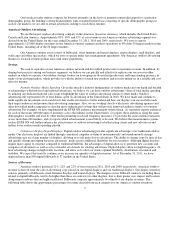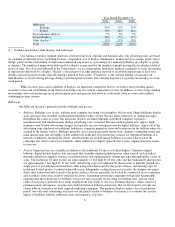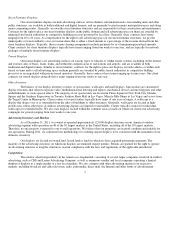iHeartMedia 2011 Annual Report Download - page 17
Download and view the complete annual report
Please find page 17 of the 2011 iHeartMedia annual report below. You can navigate through the pages in the report by either clicking on the pages listed below, or by using the keyword search tool below to find specific information within the annual report.
content for listeners and to enhance the listener experience. We have implemented commercially reasonable physical and electronic
security measures to protect against the loss, misuse, and alteration of personally identifiable information. However, no security
measures are perfect or impenetrable, and we may be unable to anticipate or prevent unauthorized access to our listeners’ personally
identifiable information. Any failure to comply with our posted privacy policies or privacy-related laws and regulations could result
in proceedings against us by governmental authorities or others, which could harm our business.
Other
Congress, the FCC and other government agencies and regulatory bodies may in the future adopt new laws, regulations and
policies that could affect, directly or indirectly, the operation, profitability and ownership of our broadcast stations and Internet-based
audio music services. In addition to the regulations and other arrangements noted above, such matters include, for example: proposals
to impose spectrum use or other fees on FCC licensees; legislation that would provide for the payment of sound recording royalties to
artists and musicians whose music is played on our broadcast stations; changes to the political broadcasting rules, including the
adoption of proposals to provide free air time to candidates; restrictions on the advertising of certain products, such as beer and wine;
frequency allocation, spectrum reallocations and changes in technical rules; and the adoption of significant new programming and
operational requirements designed to increase local community-responsive programming, and enhance public interest reporting
requirements.
Regulation of our Americas and International Outdoor Advertising Businesses
The outdoor advertising industry in the United States is subject to governmental regulation at the Federal, state and local
levels. These regulations may include, among others, restrictions on the construction, repair, maintenance, lighting, upgrading, height,
size, spacing and location of and, in some instances, content of advertising copy being displayed on outdoor advertising structures. In
addition, international regulations have a significant impact on the outdoor advertising industry. International regulation of the
outdoor advertising industry can vary by municipality, region and country, but generally limits the size, placement, nature and density
of out-of-home displays. Other regulations may limit the subject matter and language of out-of-home displays.
From time to time, legislation has been introduced in both the United States and foreign jurisdictions attempting to impose
taxes on revenue from outdoor advertising or for the right to use outdoor advertising assets. Several jurisdictions have already
imposed such taxes as a percentage of our outdoor advertising revenue in that jurisdiction. In addition, some jurisdictions have taxed
our personal property and leasehold interests in advertising locations using various valuation methodologies. While these taxes have
not had a material impact on our business and financial results to date, we expect U.S. and foreign jurisdictions to continue to try to
impose such taxes as a way of increasing revenue. In recent years, outdoor advertising also has become the subject of targeted taxes
and fees. These laws may affect prevailing competitive conditions in our markets in a variety of ways. Such laws may reduce our
expansion opportunities or may increase or reduce competitive pressure from other members of the outdoor advertising industry. No
assurance can be given that existing or future laws or regulations, and the enforcement thereof, will not materially and adversely
affect the outdoor advertising industry. However, we contest laws and regulations that we believe unlawfully restrict our
constitutional or other legal rights and may adversely impact the growth of our outdoor advertising business.
In the United States, Federal law, principally the Highway Beautification Act (“HBA”), regulates outdoor advertising on
Federal-Aid Primary, Interstate and National Highway Systems roads within the United States (“controlled roads”). The HBA
regulates the size and placement of billboards, requires the development of state standards, mandates a state’s compliance program,
promotes the expeditious removal of illegal signs and requires just compensation for takings.
To satisfy the HBA’s requirements, all states have passed billboard control statutes and regulations that regulate, among
other things, construction, repair, maintenance, lighting, height, size, spacing and the placement and permitting of outdoor advertising
structures. We are not aware of any state that has passed control statutes and regulations less restrictive than the prevailing federal
requirements, including the requirement that an owner remove any non-grandfathered, non-compliant signs along the controlled
roads, at the owner’s expense and without compensation. Local governments generally also include billboard control as part of their
zoning laws and building codes regulating those items described above and include similar provisions regarding the removal of non-
grandfathered structures that do not comply with certain of the local requirements. Some local governments have initiated code
enforcement and permit reviews of billboards within their jurisdiction challenging billboards located within their jurisdiction, and in
some instances we have had to remove billboards as a result of such reviews.
As part of their billboard control laws, state and local governments regulate the construction of new signs. Some
j
urisdictions prohibit new construction, some jurisdictions allow new construction only to replace existing structures and some
j
urisdictions allow new construction subject to the various restrictions discussed above. In certain jurisdictions, restrictive regulations
also limit our ability to relocate, rebuild, repair, maintain, upgrade, modify or replace existing legal non-conforming billboards.
14
























